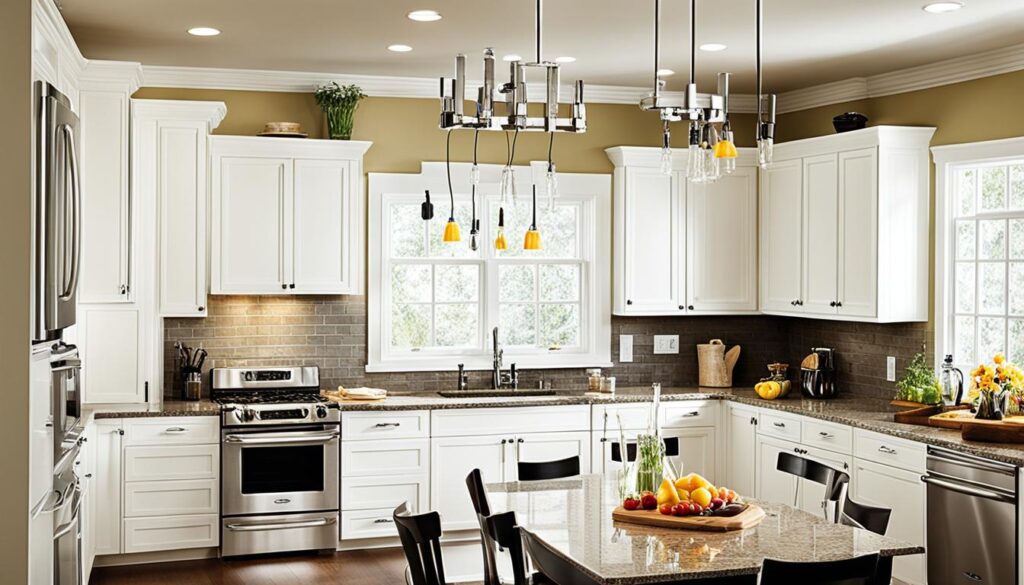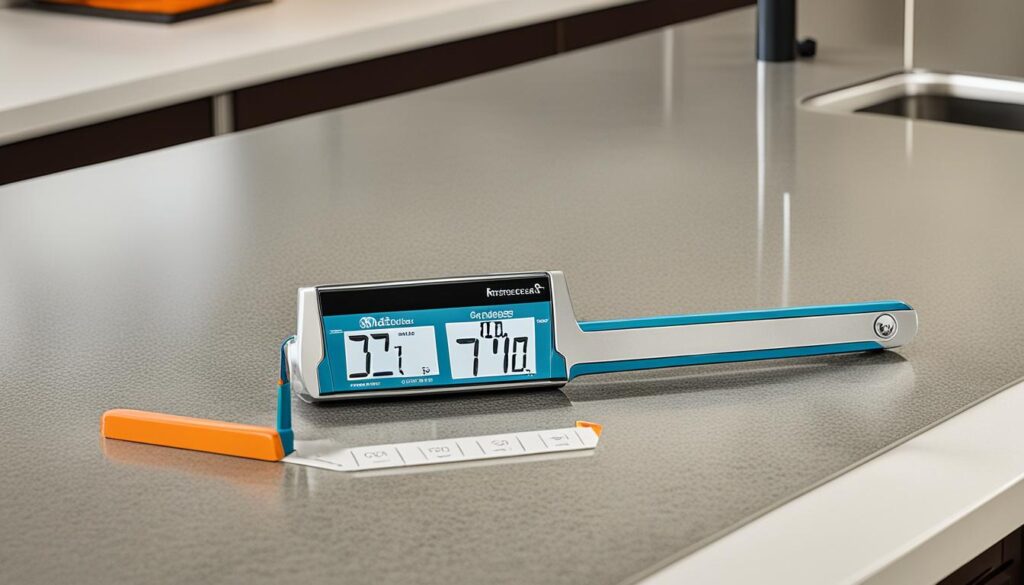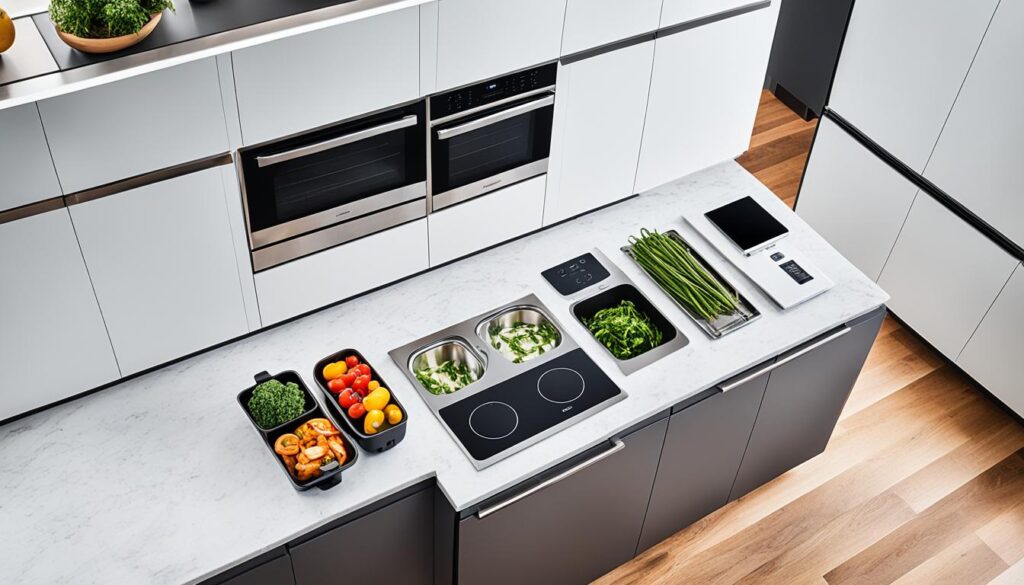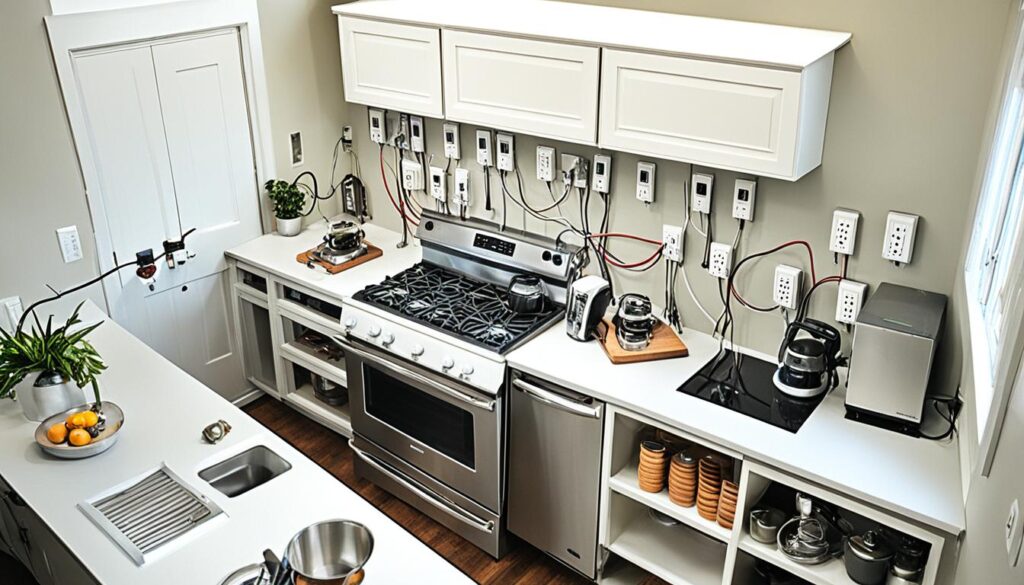When planning a new kitchen or renovating an existing one, it’s essential to consider the optimal outlet height for safety and convenience. The positioning of electrical outlets in the kitchen plays a crucial role in the overall design and usability of the space. Adhering to UK regulations and following recommended guidelines ensures that your kitchen is both functional and aesthetically pleasing.
Key Takeaways:
- Proper outlet placement in the kitchen enhances convenience and functionality during daily cooking tasks.
- Adhere to UK regulations and safety guidelines when positioning electrical outlets in the kitchen.
- Consider the concept of the “kitchen triangle” when determining outlet placement.
- Distribute kitchen appliances across different sockets and circuits to prevent overloading.
- Mount electrical equipment, including socket outlets, at suitable heights to minimize risk.
Safety Considerations for Outlet Height in the Kitchen
When it comes to the safe and efficient placement of electrical outlets in the kitchen, there are several important considerations to keep in mind. UK regulations and safety guidelines provide specific requirements that ensure the prevention of mechanical damage and potential hazards. The proper placement of outlets takes into account the presence of water and condensation levels in the kitchen, accounting for both functionality and safety.
Outlet Spacing and Height Code
In accordance with outlet height code, it is crucial to position outlets at a safe distance from potential sources of water. According to UK regulations, outlets should be placed at least 30 cm away from sinks. This ensures that there is sufficient space to prevent water damage and potential electrical hazards. Additionally, outlets should be positioned at least 15 cm above worktops to maintain safe usage and avoid any contact with liquids or spills.
By adhering to the outlet height code, you can significantly minimize the risk of accidents or damage caused by electrical outlets in the kitchen. Following these guidelines not only ensures safety but also promotes compliance with UK regulations.
Electrical Outlet Regulations in the Kitchen
Electrical outlet regulations in the kitchen are set to protect individuals from potential risks associated with the proximity of electrical outlets to water sources. These regulations are in place to prevent electrical shocks, short circuits, and other accidents that could occur due to the combination of electricity and moisture.
It is essential to consult with a qualified electrician when installing or relocating electrical outlets in the kitchen. Their expertise will ensure that the outlets are positioned correctly, taking into consideration the specific requirements outlined in the electrical outlet regulations. A qualified electrician will also ensure that the outlets are properly grounded and installed in accordance with all necessary safety measures.
“Proper installation and positioning of electrical outlets in the kitchen is crucial for safety and compliance with regulations. Hiring a qualified electrician is highly recommended to ensure that all electrical work in the kitchen is handled professionally and minimizes the risk of accidents.”

| Regulations | Requirements |
|---|---|
| Outlet Spacing | At least 30 cm away from sinks |
| Outlet Height | At least 15 cm above worktops |
| Qualified Electrician | Ensure proper installation and compliance |
| Proper Grounding | Minimize the risk of electrical hazards |
By understanding and following the safety considerations and regulations for outlet height in the kitchen, you can create a safe and functional environment for your cooking and food preparation activities.
Convenience and Functionality of Outlet Placement in the Kitchen
Proper outlet placement in the kitchen enhances convenience and functionality during daily cooking tasks. When designing your kitchen, it’s important to consider both the standard outlet height and the countertop outlet height to ensure optimal usage. By strategically locating outlets, you can create a kitchen that is both practical and visually appealing.
One key consideration in outlet placement is the concept of the “kitchen triangle.” The kitchen triangle includes the three main work areas: the cooker, fridge, and sink. To avoid obstacles and ensure ease of movement, it is recommended to install outlets outside the triangle area. This way, you can freely access these essential areas without hindrance from power cords.
Another smart outlet placement idea is to consider installing outlets inside cupboards and drawers. This not only allows you to power hidden appliances like coffee makers and toasters, but also keeps your countertops clutter-free, providing a cleaner and more organized aesthetic.
To determine the number of sockets required in your kitchen, strike a balance between aesthetics and convenience. Consider your cooking habits, the number of appliances or gadgets requiring power, and the layout of your kitchen. It’s advisable to consult with an electrician to ensure the placement of outlets meets safety guidelines and follows electrical regulations.
By carefully considering the standard outlet height in the kitchen and the countertop outlet height, you can create a functional and efficient workspace that meets your cooking needs and enhances your overall culinary experience.
The Convenience of Hidden Outlets
Placing outlets inside cupboards and drawers offers a clever way to hide appliances and power devices without compromising the aesthetics of your kitchen. By integrating hidden outlets, you can maintain a seamless and clutter-free countertop surface. This not only improves the visual appeal of your kitchen but also allows you to keep your appliances neatly organized and easily accessible.
Expert Tip: Balance Aesthetics and Functionality
When deciding on the number of outlets and their placement, it’s crucial to strike a balance between aesthetics and functionality. While having sufficient outlets is essential for powering your appliances, you also want to maintain a visually pleasing kitchen design. Consider your personal cooking habits and the layout of your kitchen to determine the optimal placement of outlets. Consulting with an electrician can provide valuable insights and ensure that your kitchen meets safety standards and electrical regulations.

Power Requirements and Considerations for Kitchen Appliances
When it comes to designing your kitchen, it’s important to understand the power requirements of your appliances. Different kitchen appliances have varying power needs, which are typically measured in watts. By distributing your appliances across different sockets and circuits, you can avoid overloading a single outlet and ensure the safe and efficient operation of your kitchen.
When determining the optimal outlet height in your kitchen, it’s crucial to consider the wattage of your appliances. Higher wattage appliances like kettles and washer-dryers require dedicated sockets to handle their heavier loads. This eliminates the risk of overloading regular outlets, preventing potential electrical hazards in your kitchen.
Consulting with a qualified electrician is key when determining the placement of your appliances and their corresponding power requirements. An electrician can assess your kitchen layout, ensuring that the optimal outlet height is achieved for each appliance’s specific power needs. This ensures that your appliances operate safely, efficiently, and in compliance with electrical regulations.
“Proper power distribution and consideration of the wattage of your kitchen appliances are essential for a safe and functional kitchen.”
Recommended Outlet Heights for Common Kitchen Appliances
| Appliance | Recommended Outlet Height |
|---|---|
| Refrigerator | Approximately 15 cm above the floor |
| Stove/Oven | Approximately 15 cm above the worktop |
| Dishwasher | Approximately 15 cm above the floor |
| Microwave | Approximately 15 cm above the worktop |
| Kettle | Dedicated socket at an appropriate height |
| Washer-Dryer | Dedicated socket at an appropriate height |
By adhering to these recommended outlet heights for common kitchen appliances, you can ensure that your kitchen is both functional and safe to use. Remember, consulting with a professional electrician is paramount to assess your specific kitchen layout, power requirements, and to ensure compliance with regulations.

Mounting Heights of Electrical Equipment in Dwellings
When it comes to ensuring the safety and functionality of electrical outlets in your kitchen, it is important to consider the proper mounting heights. British Standard BS 7671 provides guidelines for the mounting heights of all electrical equipment, including socket outlets, in dwellings.
The main objective of these regulations is to minimize the risk of mechanical damage and wetting from floor cleaning. By mounting socket outlets at a sufficient height, you can prevent accidental damage and potential hazards in your kitchen.
Additionally, Approved Document M, which is part of the Building Regulations for England and Wales, emphasizes the importance of suitable mounting heights for wall-mounted switches and socket outlets in new dwellings. This ensures that the placement of electrical equipment is not only safe but also meets the necessary accessibility requirements.
To further cater to the needs of disabled individuals, BS 8300: 2009 offers recommendations on mounting heights for equipment in dwellings. By following these guidelines, you can create an inclusive space that accommodates everyone’s needs and promotes independence.
Summary of Mounting Heights Guidelines:
When mounting electrical equipment in your kitchen, such as socket outlets and switches, it is essential to consider the following recommended heights:
- Mount socket outlets at a height that minimizes the risk of mechanical damage and wetting from floor cleaning.
- Follow the guidelines provided by British Standard BS 7671 for the specific mounting heights of electrical equipment in dwellings.
- Refer to Approved Document M for suitable mounting heights of wall-mounted switches and socket outlets in new dwellings.
- Consult BS 8300: 2009 for recommendations on mounting heights to meet the needs of disabled people.
By adhering to these guidelines, you can ensure the safe and efficient use of electrical outlets in your kitchen, providing a functional space for all your cooking needs.

Conclusion
When it comes to creating a safe and functional kitchen, selecting the optimal outlet height is essential. By carefully considering factors such as safety requirements, appliance power, and accessibility, you can ensure that your kitchen is not only compliant with regulations but also designed with convenience in mind.
To achieve the best results, it is highly recommended to consult with a qualified electrician who can provide expert guidance based on your specific needs. They will help you navigate the complexities of outlet placement and ensure that you have the right number of sockets to accommodate your appliances.
By following the guidelines discussed throughout this article, you can create a well-designed and efficient kitchen space that meets both your aesthetic preferences and functional requirements. Remember, safety should always be a top priority, so take the time to plan and consider the optimal outlet height for your kitchen.
With careful planning and expert advice, you can create a kitchen that not only looks great but also works harmoniously with your daily cooking needs.

